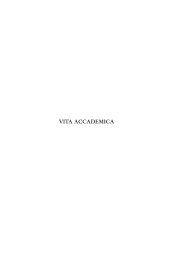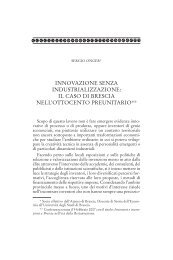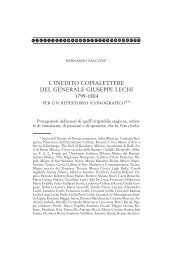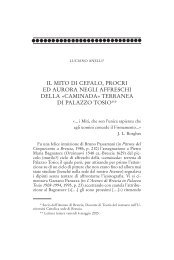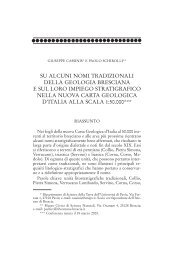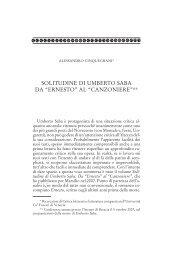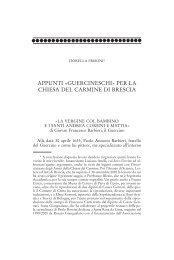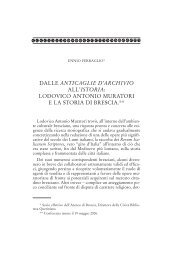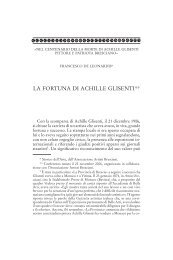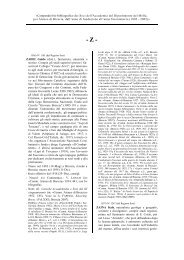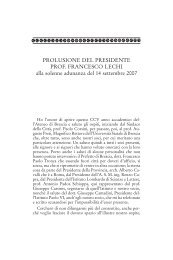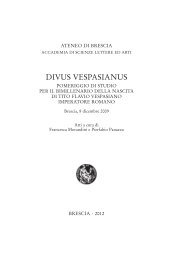do handel's cantatas matter? - BOLbusiness
do handel's cantatas matter? - BOLbusiness
do handel's cantatas matter? - BOLbusiness
Create successful ePaper yourself
Turn your PDF publications into a flip-book with our unique Google optimized e-Paper software.
«HÄNDEL E LE CANTATE IN LINGUA ITALIANA»<br />
ELLEN T. HARRIS*<br />
«CANTATE, QUE ME VEUX-TU?», OR:<br />
DO HANDEL’S CANTATAS MATTER?**<br />
The French author Bernard le Bovier de Fontenelle is said<br />
to have asked disparagingly about Italian instrumental, chamber<br />
music: «Sonate, que me veux-tu?» Today we might ask the<br />
same question of the Italian chamber cantata: «What good are<br />
you?» 1 . Little musical importance, it seems, is attached to this<br />
pervasive Baroque form, even in the hands of a composer such<br />
as George Frideric Handel. While pathbreaking archival work<br />
by Ursula Kirkendale and Hans Joachim Marx has added significantly<br />
to our knowledge about their chronology and context<br />
2 , Handel’s <strong>cantatas</strong> continue to be lumped together by<br />
* MIT di Boston.<br />
** Relazione tenuta nella «Giornata internazionale di studi: Händel in<br />
Italia» del 26 ottobre 2005, nel corso della III edizione della rassegna «Nuove<br />
settimane di Musica Barocca in Brescia e provincia».<br />
1 William S. Newman provides this colloquial translation, which strikes<br />
me as better and more accurate than the literal «What <strong>do</strong> you want of me?».<br />
The Sonata in the Baroque Era, New York, W. W. Norton & Co., 1972, p.<br />
31.<br />
2 URSULA KIRKENDALE, The Ruspoli Documents on Handel, in «Journal<br />
of the American Musicological Society», 20 (1967), pp. 222-273; HANS<br />
JOACHIM MARX, Die Musik am Hofe Pietro Kardinal Ottobonis unter Ar-
214 ELLEN T. HARRIS<br />
[2<br />
most biographers as early compositions with relatively uninteresting<br />
texts, typically depicting the trials of a lovelorn shepherd<br />
and «couched in a fashionable pastoral convention» 3 ;<br />
with a few familiar exceptions (such as La Lucrezia and Agrippina<br />
con<strong>do</strong>tta a morire) they tend to be passed over quickly<br />
on the way to what has been considered Handel’s genuine (and<br />
much more substantive) musical contributions of opera, oratorio,<br />
anthem, suite and concerto. I have always felt differently.<br />
From my first contact with the <strong>cantatas</strong>, I marveled at<br />
their musical richness, and as I continued to study them I became<br />
increasingly convinced of their importance to Handel’s<br />
life and musical development. Their compositional history<br />
paints a distinctive picture of private music patronage, so different<br />
from the public arena that quickly absorbed Handel after<br />
his arrival in Lon<strong>do</strong>n; the texts, behind a pastoral façade,<br />
embody a deeply emotional utterance resonant of personal,<br />
political and religious issues; and the musical settings illustrate<br />
a composer already in the first bloom of his maturity in both<br />
the musical penetration of the text and the development of<br />
stylistic features that distinguish his most advanced works.<br />
My book Handel as Orpheus: Voice and Desire in the Chamber<br />
Cantatas (2001) looks at Handel’s astonishing corpus of<br />
<strong>cantatas</strong> in these three ways – in terms of context, text and music<br />
– and my hope is that in time it will prove to have played<br />
a role in the increasing recognition of the surpassing beauty of<br />
these works4 . I rejoice, therefore, in the plan of La Risonanza<br />
to perform and record all of Handel’s instrumental <strong>cantatas</strong><br />
cangelo Corelli, in «Analecta Musicologica» 5 (1968), pp. 104-177; idem, Ein<br />
Beitrag Händels zur Accademia Ottoboniana in Rom, in «Hamburger<br />
Jahrbuch für Musikwissenschaft» 1 (1974), pp. 69-86; idem, Händel im Rom-<br />
Seine Beziehung zu Benedetto Card. Pamphilj, in «Händel Jahrbuch» 29<br />
(1983), pp. 107-118; idem, Die ‘Giustificazioni della Casa Pamphilj’ als<br />
Musikgeschichtliche Quelle, in «Studi Musicali» 12 (1983), pp. 121-187.<br />
3 DONALD BURROWS, Handel, New York, Schirmer Books, 1994, p. 24.<br />
4 ELLEN T. HARRIS, Handel as Orpheus: Voice and Desire in the Chamber<br />
Cantatas, Cambridge, Mass., Harvard University Press, 2001.
3] «Cantate, que me veux-tu?», or: Do Handel’s <strong>cantatas</strong> <strong>matter</strong>? 215<br />
with close attention to the autograph scores and the original<br />
performing forces and style. I am very grateful to the group<br />
for making it possible for me to be here for this first performance<br />
in Brescia, and I am honored to have the opportunity<br />
to speak to you today. For my paper, I would like to focus on<br />
a work we will hear tonight, the first cantata of Handel’s to be<br />
named in contemporary <strong>do</strong>cuments: Il delirio amoroso.<br />
An entry in the account books of Cardinal Benedetto Pamphili<br />
dated 12 February 1707 provides a detailed bill for copying<br />
«di musica nella Cantata intitolata *Il delirio amoroso…<br />
Composta in musica dal S. re Giorgio Hendel» 5 . Although this<br />
extremely important <strong>do</strong>cument provides the earliest piece of<br />
firm evidence about Handel’s Italian compositions, it <strong>do</strong>es not<br />
indicate that Il delirio amoroso was the first cantata Handel<br />
wrote in Italy. However, the date of the bill must follow the<br />
composition and copying, and may postdate the performance<br />
as well, taking us as far back as January 1707, close to the time<br />
when Handel first arrived in Rome.<br />
Francesco Valesio mentions in a diary entry of 14 January<br />
«un sassone eccelente sonatore di cembalo e compositore di<br />
musica» who has recently arrived in Rome and who had that<br />
day demonstrated his skill «in sonare l’organo nella chiesa di<br />
S. Giovanni con stupore di tutti» 6 . As Handel probably left<br />
Germany soon after the production of Reinhold Keiser’s Octavia<br />
in Hamburg in August, 1705, he was probably in northern<br />
Italy for at least a year before his arrival in Rome. His first<br />
biographer John Mainwaring says just that, placing the composer<br />
first in Florence for «near a year» and then in Venice.<br />
There can be little <strong>do</strong>ubt that Handel was musically active during<br />
this time, as, again, Mainwaring states: «The fame of his<br />
5 MARX, Giustificazioni, p. 177.<br />
6 URSULA KIRKENDALE, Orgelspiel im Lateran und andere Erinnerungen<br />
an Händel: Ein unbeachteter Bericht in ‘Voiage historique’ von 1737, in<br />
«Die Musikforschung» 41 (1988), pp. 1-9 (1); OTTO ERICH DEUTSCH, Handel:<br />
A Documentary Biography, New York, Da Capo Press, 1974, p. 19 (in<br />
English translation).
216 ELLEN T. HARRIS<br />
[4<br />
musical achievements at Florence and at Venice had reached<br />
that metropolis [Rome] long before him. His arrival therefore<br />
was immediately known, and occasioned civil enquires and<br />
polite messages from persons of the first distinction there» 7 .<br />
Cardinal Pamphili stands out as an important patron of<br />
Handel’s not only on account of the early <strong>do</strong>cumented evidence<br />
of compositions. In addition, the opportunity Handel,<br />
a Lutheran, had to play an organ recital at the church of S.<br />
Giovanni Laterano, the Pope’s own sanctuary, must likely be<br />
attributed to Pamphili, who had been named archpriest of the<br />
Lateran in 1699, a post he held until his death in 1730 8 . When<br />
Handel arrived in Rome, he probably carried with him letters<br />
of introduction from Florence, or, alternatively such letters<br />
may have preceded him. The early association of Handel in<br />
Rome with Pamphili, suggests that a recommendation might<br />
have come from Cardinal Francesco Maria de’ Medici, a<br />
«grande amico» of Pamphili, according to his biographer Lina<br />
Montalto 9 . The two men apparently shared musical interests;<br />
in 1690 Pamphili had sent Cardinal Medici a richly bound set<br />
of <strong>cantatas</strong> by Alessandro Scarlatti, including a Lucrezia romana<br />
with a text by Pamphili 10 . Perhaps in late 1706, Cardinal<br />
Medici gave Handel a letter of introduction to Pamphili<br />
to be accompanied with a gift of Handel’s La Lucrezia, a cantata<br />
I place into the pre-Rome compositional period 11 , com-<br />
7<br />
JOHN MAINWARING, Memoirs of the Life of the late George Frederic<br />
Handel, Lon<strong>do</strong>n, R. and J. Dodsley, 1760; fac. ed.: Buren, Fritz Knuf,<br />
1964/1975, pp. 51, 54.<br />
8<br />
LINA MONTALTO, Un mecenate in Roma barocca: Il Cardinale<br />
Benedetto Pamphilj (1653-1730), Florence, Sansoni, 1955, «La colomba<br />
Pamphilja nella basilica lateranense fra il 1699 e il 1730», pp. 433-449.<br />
9 Ivi, p. 232.<br />
10 Ivi, p. 330.<br />
11<br />
HARRIS, Handel as Orpheus, pp. 88-90; 269-270; 49-58, 73-76. KIRK-<br />
ENDALE, Ruspoli Documents, argued that this cantata was written in Rome<br />
(pp. 246-247); see also Idem, Handel with Ruspoli, pp. 326-327, where she<br />
reiterates her argument for a Roman provenance for La Lucrezia and dismisses<br />
the possibility of dating this and other works by style or handwrit-
5] «Cantate, que me veux-tu?», or: Do Handel’s <strong>cantatas</strong> <strong>matter</strong>? 217<br />
missioned for that purpose. But this is conjecture. In fact, trying<br />
to connect Handel’s introduction to Rome with a single<br />
patron is simplistic, and probably futile, as Handel was quickly<br />
drawn into a network of patronage.<br />
A copying bill for music by Handel appears in the accounts<br />
of the Marquis Ruspoli by May 1707, and Ursula Kirkendale<br />
suggests a still earlier relationship in her hypothesis that a<br />
copying bill in the Ruspoli accounts of the previous December<br />
for «una cantata nuova» (no title or composer is given)<br />
refers to Handel’s Arresta il passo12 . Sometime in the spring<br />
of 1707, Handel also must have been commissioned by Cardinal<br />
Carlo Colonna for the psalms and motets that were composed<br />
for the Festival of Our Lady of Mount Carmel on 16<br />
July. The patron who plays the biggest role in Mainwaring’s<br />
account of Handel’s Roman tenure, however, is none of these<br />
but rather Cardinal Pietro Ottoboni, about whose relationship<br />
with Handel little can be said definitively. Colonna and<br />
Pamphili are mentioned by Mainwaring more briefly, Ruspoli<br />
not at all. Mainwaring identifies Ottoboni as one of Handel’s<br />
«greatest admirers» and specifically mentions the importance<br />
of the cardinal’s «large library of Music» and the «excellent<br />
band of performers», which included «the illustrious Corelli»<br />
13 . It seems increasingly clear that in Rome, if not in Italy<br />
more broadly, one must speak of a complex system of artistic<br />
patronage.<br />
Regular gatherings at the houses of patrons or musicians<br />
and more formal concerts both in private homes or churches<br />
supported a shared culture of intellectual thought and values.<br />
A description of Handel in Rome, published in 1737 (by an<br />
anonymous author reporting on the memoirs of a friend),<br />
ing (although later, p. 337, she depends on handwriting analysis as evidence<br />
for her otherwise unsupported claim that Rodrigo and Agrippina were both<br />
composed before 1707).<br />
12<br />
KIRKENDALE, Handel with Ruspoli, pp. 305-306.<br />
13<br />
MAINWARING, Handel, pp. 54-55.
218 ELLEN T. HARRIS<br />
[6<br />
states not only that Handel’s concert at St. John Lateran was<br />
attended by an extraordinary audience, «above all Cardinals,<br />
Prelates and the Nobility», but that Handel «made visits in<br />
Rome to all the respected Musicians of some reputation». He<br />
specifically describes an assembly the evening before the Lateran<br />
concert at the house of the Pasqualini family, the «famous<br />
musicians of the Pope», which gathered together all the «able<br />
musicians of Rome known either for their voice or instrument»<br />
14 . One member of this family, Pasqualino Tiepoli, soprano<br />
castrato in the papal chapel, appears as well in Pamphili’s<br />
account books, and may have been the singer who premiered<br />
Il delirio amoroso 15 .<br />
Pamphili himself wrote the text of Il delirio amoroso 16 . Its<br />
story line can be described in traditional terms, as in the liner<br />
notes of a recent recording: «The text of the cantata is<br />
couched in the Arcadian literary conventions that were fashionable<br />
in Rome at the time. Clori is distraught at the loss of<br />
her lover Tirsi [...]. Narrative recitatives frame the text, but<br />
otherwise the ‘voice’ of the singer is that of Clori as she de-<br />
14 URSULA KIRKENDALE, Orgelspiel, p. 3; WERNER BRAUN, Händel und<br />
der ‘römische Zauberhut’(1707), in «Göttinger Händel Beiträge» 3 (1989),<br />
pp. 71-86, gives the author as Denis Nolhac (p. 72), based on the research<br />
of Jean-Daniel Candaux (p. 82 n7).<br />
15 MARX, Händel in Rom, p. 109, identifies Pasqualino as the singer<br />
who gave the first performance of Il delirio amoroso. KIRKENDALE, Orgelspiel,<br />
p. 5 n20 points out, however, that the <strong>do</strong>cument of 18 February in the<br />
Pamphili accounts listing payments to musicians for the months January and<br />
February indicates only four performances and one rehearsal for Pasqualino,<br />
while the castrato Checchino (possibly Francesco de Castris, the singer<br />
with whom Ferdinand de’ Medici had an intimate affair who was in exile in<br />
Rome) was paid for seven performances and multiple rehearsals; thus the<br />
identity of the singer at the premiere remains a question. For details on the<br />
life of Francesco de Castris, see WARREN KIRKENDALE, The Court Musicians<br />
in Florence during the Principate of the Medici, Florence, Leo. S. Olschki,<br />
1993, pp. 437-446.<br />
16 Whether or not it was specifically written for Handel to set is not<br />
known; see MARX, Händel im Rom, pp. 108 and 116 n7, and MONTALTO,<br />
Un mecenate, pp. 335 and 505.
7] «Cantate, que me veux-tu?», or: Do Handel’s <strong>cantatas</strong> <strong>matter</strong>? 219<br />
scribes her search for Tirsi, using the imagery of the underworld<br />
from pagan classical mythology. Eventually she arrives<br />
at ‘blessed Elysium’» 17 . Seeing the text only in this manner<br />
misses, I believe, a great deal. The Roman circle of patrons<br />
were not only highly educated, but as members of the Arcadian<br />
Academy they supported the rescue of Italian literature<br />
from seventeenth-century extravagances («mannerism»)<br />
through the return to classical balance and symmetry. The idealized<br />
simplicity of the classical pastoral served as a model,<br />
and all members of the Academy took on pastoral pseu<strong>do</strong>nyms,<br />
but this should not suggest that the Arcadians themselves<br />
were simple or superficial in thought or deed. The pastoral<br />
poetry of Theocritus and Virgil they took as a model was<br />
itself complex, with political, religious and personal messages<br />
lying not so far beneath the surface. Further, their chosen pastoral<br />
names indicate the intricate and allegorical nature of their<br />
pursuit: for example, Pamphili’s Arcadian name, Fenicio Larisseo,<br />
referred, according to Montalto, to Queen Christina of<br />
Sweden, in whose honor the Academy was founded, as «the<br />
symbolic phoenix under whose influence Pamphili had spent<br />
his youth» 18 . With such symbolism embedded even in their<br />
choice of names, it seems rash to look merely at the pastoral<br />
façade of the cantata texts.<br />
The story of Il delirio amoroso can be described as a «quest»<br />
narrative, depicting a dangerous undertaking to recover a valuable<br />
object. The trip to the Underworld immediately brings<br />
to mind similar quest narratives for deceased beloveds, such<br />
as that taken by Orpheus for Euridice or Hercules for Alceste,<br />
that would have been very familiar to the audience and<br />
would have made the similarities and differences between the<br />
stories stand out. In the quests for Euridice and Alceste, the<br />
goal is to return a cherished beloved to earth, and in both the<br />
17 DONALD BURROWS, CD liner notes, Handel, Italian Cantatas with<br />
Magdalena Ko`zená and Les Musiciens du Louvre, Marc Minkowski conducting,<br />
Hamburg, Deutsche Grammophon, 2000.<br />
18 MONTALTO, Un mecenate, p. 193.
220 ELLEN T. HARRIS<br />
[8<br />
beloved wishes to be reunited with her lover; the quests differ<br />
in that Orpheus seeks his own beloved but fails to bring<br />
her safely back to earth, while Hercules undertakes the quest<br />
for his friend Admeto and succeeds in bringing Alceste back<br />
to her husband. Il delirio amoroso diverges from both of these<br />
in that Clori’s beloved Tirsi has rejected her love on earth and,<br />
in her mind, he continues to turn his back even when she finds<br />
him in Hades, yet she forgives him and proves her undying<br />
love by leading him from Hades to Elysium.<br />
As I have tried to show in Handel as Orpheus, Handel’s<br />
cantata texts frequently resonate with multiple meanings, often<br />
with overlapping religious, political and personal associations.<br />
The text of Il delirio amoroso is no exception. I have<br />
suggested previously that the text has religious overtones, perhaps<br />
representing a distraught soul who thinks she has been<br />
deserted by Christ; she imagines herself descending into Hell,<br />
where she still feels rejected; ultimately her journey of faith<br />
allows her to be united with Christ in heaven19 . The text might<br />
also, in contrast, describe the anguish of a pastor who pursues<br />
a lost soul in order to lead him out of darkness into heaven.<br />
The quest metaphor also could apply to politics, representing<br />
the search for a political union or treaty (perhaps, at this time,<br />
relating to the War of Spanish Succession). Obviously, the text<br />
could also depict a pursuit or quest within a spectrum of personal<br />
relationships, ranging from collegial to intimate.<br />
The flexible nature of pastoral texts is, in my view, inherent<br />
to their meaning, and just as seeing only the pastoral façade<br />
is too general, so too is a single, fixed reading too limited. It<br />
is clear that the <strong>cantatas</strong> often referred to specific individuals.<br />
Handel is mentioned by name in the text of Hendel, non può<br />
mia musa, also by Pamphili. Ruspoli is mentioned by his Arcadian<br />
name, Olinto [Arsenio], in Handel’s cantata O come<br />
chiare, which comments specifically on the War of Spanish<br />
Succession. Further, the association of the conventional pas-<br />
19 HARRIS, Handel as Orpheus, pp. 81-82.
9] «Cantate, que me veux-tu?», or: Do Handel’s <strong>cantatas</strong> <strong>matter</strong>? 221<br />
toral texts with the lives of the authors and auditors is indicated<br />
in the watercolor miniatures with Roman backgrounds<br />
associated with the <strong>cantatas</strong> in two manuscripts compiled for<br />
the castrato Andrea Adami, a singer in residence at the palace<br />
of Cardinal Ottoboni from 1686 to 1740 20 . Typically, however,<br />
the value of the pastoral resided in its ambiguity and the<br />
ability to suggest without naming, an aesthetic apparently<br />
shared by the miniatures which imply a Roman analogy without<br />
depicting specific people.<br />
Ursula Kirkendale, in contrast, has suggested that the couple<br />
in Handel’s Arresta il passo specifically portray «Ruspoli,<br />
disguised as the shepherd Aminta [who] detains the nymph<br />
Phyllis representing Handel» and that the cantata enacts a<br />
«playful dialogue» whose «subtext is a serious musical ‘contract’».<br />
She uses this interpretation to reinforce her proposed<br />
early dating of the cantata to December 1706 21 . However, there<br />
is no evidence for this reading, and most of the <strong>cantatas</strong> describe<br />
similar narratives. For example, Il delirio amoroso could<br />
equally represent Pamphili as the nymph Clori, pursuing Handel,<br />
the recalcitrant Tirsi. Given Cardinal Pamphili’s evident<br />
attraction to the young composer, as expressed in two other<br />
texts by him that were set by Handel in 1707, Hendel, non può<br />
mia musa and Il trionfo del tempo ed il disinganno 22 . it could<br />
be tempting, even titillating, to suggest a personification reading<br />
that depicts Pamphili’s pursuit, romantic rather than contractual,<br />
of the recalcitrant Handel to hell and beyond. Being<br />
able to read a hint of homoeroticism, or any other type of per-<br />
20 Ivi, pp. 86-87; see also REINHARD STROHM, Scarlattiana at Yale, in<br />
Händel e gli Scarlatti a Roma, ed. Nino Pirrotta and Agostino Ziino, Florence,<br />
Leo S. Olschki, 1987, pp. 113-152; Zach Victor is currently undertaking<br />
further research into the meaning of these miniatures, and I am grateful<br />
to him for sharing with me his unpublished paper The Ink Miniature<br />
and the Cantata in Handel’s Italy, presented at the American Handel Society<br />
Festival (Santa Fe, 2005).<br />
21<br />
KIRKENDALE, Handel with Ruspoli, p. 306.<br />
22<br />
HARRIS, Handel as Orpheus, pp. 43-45.
222 ELLEN T. HARRIS<br />
[10<br />
sonification, into a cantata, however, <strong>do</strong>es not establish that its<br />
sole meaning, or even as one of its meanings 23 . As Robert<br />
Hume has written, «The inclination to construct elaborate parallels<br />
and personification readings should be resisted where<br />
there is no extrinsic evidence with which to validate them.<br />
However ingenious or textually plausible they may seem, they<br />
are not a sound form of historical scholarship» 24 .<br />
Because of its early date, Il delirio amoroso offers the best<br />
example of Handel’s musical style at the outset of his Roman<br />
sojourn. The overall movement plan is extensive, including<br />
four arias, an instrumental introduction and interior instrumental<br />
movements with the final aria a vocal minuet. Following<br />
the opening sonata, the vocal section of the cantata begins<br />
and ends in recitative, and the individual movements are<br />
generous in length and style. In contrast, Handel’s <strong>cantatas</strong><br />
that can be dated to 1708 demonstrate a newfound restraint<br />
and formal regularity, typically falling into the pattern of two<br />
recitative-aria pairs with the arias consistently in da capo form.<br />
The very use of instrumental accompaniment for a solo cantata<br />
seems to be a trait associated primarily with early works.<br />
The instrumental <strong>cantatas</strong> of 1708 and later typically are constructed<br />
dramatically with two or more characters, not as solo<br />
scenas, and the individual arias are less impassioned than<br />
23 I did not propose this interpretation in Handel as Orpheus, but it<br />
certainly exists within the circle of possible, multiple readings.<br />
24 ROBERT D. HUME, The Politics of Opera in Late Seventeenth-Century<br />
Lon<strong>do</strong>n, in «Cambridge Opera Journal» 10 (1998), pp. 15-43 (42-43).<br />
KIRKENDALE, Handel with Ruspoli, attacks my association of homoeroticism<br />
with the <strong>cantatas</strong> without addressing either the classical models of pastoralism<br />
or the contemporary context, arguing that my general interpretations<br />
are «implausible» (p. 306 n34) while providing specific, personification<br />
readings that not only are unsupported by <strong>do</strong>cumentary evidence but<br />
are more re<strong>do</strong>lent of homoeroticism than anything I suggest. I have responded<br />
to Kirkendale’s critique in Homosexual Context and Identity: Reflections<br />
on the Reception of «Handel as Orpheus», forthcoming in the proceedings<br />
of a conference in Queer Studies (Cambridge University, July,<br />
2002).
11] «Cantate, que me veux-tu?», or: Do Handel’s <strong>cantatas</strong> <strong>matter</strong>? 223<br />
those of the earlier solo <strong>cantatas</strong>. Among the earlier works, an<br />
unsettled mode of expression – using wide and dissonant intervals,<br />
chromatic harmonies, and explosions of fioratura in<br />
recitatives – is particularly true of solo <strong>cantatas</strong>, like Il delirio<br />
amoroso, that depict the voice of a woman 25 .<br />
By studying the style features of this and other dated <strong>cantatas</strong>,<br />
it is possible to suggest earlier or later dates for works<br />
without a fixed chronology. La Lucrezia, for example, is surely<br />
an early work, whether or not its composition predates<br />
Handel’s arrival in Rome, and the copying bill that appears in<br />
Ruspoli’s accounts on 31 August 1709, long after Handel had<br />
left Rome, clearly represents the creation of a later copy for<br />
archival or gift purposes 26 . The style features of Il delirio<br />
amoroso may also put Johann Mattheson’s criticism of Handel’s<br />
early style into perspective. He writes in 1740 that when<br />
Handel arrived in Hamburg in 1703, «he composed very long,<br />
long arias, and really interminable <strong>cantatas</strong>, which had neither<br />
the right kind of skill nor taste, though complete in harmony,<br />
but the lofty schooling of opera soon trimmed him into other<br />
fashions» 27 . Mattheson’s melodic ideal was for short, tuneful<br />
and natural melodies, in which «the French should be imitated<br />
more than the Italians» 28 . Not that Mattheson didn’t<br />
compose in the Italian, virtuosic style, but more typically, as<br />
in his opera Cleopatra (1704), his arias are strophic and syllabic<br />
with a folklike, somewhat galant, character.<br />
25 For a more detailed discussion of these stylistic traits, see HARRIS,<br />
Handel as Orpheus, passim.<br />
26 KIRKENDALE, Ruspoli Documents, pp. 268-269 (under title «O Numi<br />
eterni»).<br />
27 Grundlage einer Ehren-Pforte, p. 93.<br />
28 GEORGE J. BUELOW, An evaluation of Johann Mattheson’s opera,<br />
Cleopatra (Hamburg 1704), in Studies in Eighteenth-Century Music: A Tribute<br />
to Karl Geiringer on his Seventieth Birthday, ed. H. C. Robbins Lan<strong>do</strong>n,<br />
New York, Oxford University Press, 1970, pp. 92-107 (95); see also<br />
JOHANN MATTHESON, Cleopatra, in Das Erbe Deutscher Musik 69, ed.<br />
George J. Buelow, Mainz, B. Schott’s, 1975.
224 ELLEN T. HARRIS<br />
[12<br />
The first aria of Il delirio amoroso may, therefore, represent<br />
the style that Mattheson censures; if so, we may respectfully<br />
disagree with his critique. «Un pensiero» bears no resemblance<br />
to Mattheson’s rules for natural melody, for French rather than<br />
Italian style, or for conciseness rather than prolixity29 . Rather,<br />
it extends over 166 measures in common time and includes an<br />
extensive solo violin part, frequently playing unaccompanied<br />
at the rate of two 16th-note triplets per quarter note for as long<br />
as nine measures at a time. The vocal line also has many extensions<br />
of up to six measures each, both of single notes and<br />
serpentine runs. Although Handel <strong>do</strong>es not share Mattheson’s<br />
goals, he is not, in my view, simply striving toward virtuosity<br />
for its own sake. Rather, the aria expresses, even enacts, the<br />
text, both in its detail and in its very length.<br />
In the A section of this da capo aria, Clori expresses the<br />
hope that her thought will fly up to heaven if Tirsi who stole<br />
her peace is there. Handel’s setting vividly contrasts the flight<br />
of the thought to the furthest reaches with the constancy of<br />
peace. Whereas the opening, unaccompanied melisma on the<br />
word «pensiero» encompasses more than five measures and<br />
fifty-five notes over a range of an octave and a fourth, the later<br />
extension on the word «pace» consists of a single note sustained<br />
for five and a half measures against rapid solo figuration<br />
in the violin. These depictions are not unique. Each of<br />
the emotional states, agitated thought and peace of mind, represents<br />
a recurring textual and musical topos (sign or gesture)<br />
in other <strong>cantatas</strong> from this early period. For example, the continuo<br />
cantata Lungi da me, pensier tiranno plays with this contrast<br />
throughout using the same musical means. Like La Lucrezia,<br />
Lungi da me was copied for Ruspoli in 1709, appearing<br />
in the same copying bill of August 31, and, also like La<br />
Lucrezia, its style characteristics indicate an early date. The<br />
cantata contains three arias, not the standard two of later<br />
works, and the last of these, in 3/8 time, resembles a closing<br />
29 BUELOW, Johann Mattheson’s Opera, p. 95.
13] «Cantate, que me veux-tu?», or: Do Handel’s <strong>cantatas</strong> <strong>matter</strong>? 225<br />
minuet, similar to the final aria in Il delirio amoroso. In the<br />
second aria, «Fuggi da questo sen», it becomes the central focus<br />
of the A section text:<br />
Fuggi da questo sen Fly from this breast,<br />
O barbaro pensier, O barbarous thought,<br />
Lasciami in pace! Leave me in pace.<br />
In his setting of this text, Handel places the agitated melisma<br />
on the word «barbaro», which defines the quality of the<br />
«pensier». Again, as in Il delirio amoroso, the word «pace» is<br />
extended on a single note.<br />
The <strong>cantatas</strong> overall demonstrate the growing importance<br />
of musical topoi to Handel’s compositional practice, and the<br />
second aria of Il delirio amoroso, «Per te lasciai la luce», provides<br />
another example: the use of silence. Although silence<br />
in music is often said to have emerged only in the Classical<br />
era, Handel increasingly incorporates dramatic silences in his<br />
music30 . He, of course, a<strong>do</strong>pts the word-painting silences of<br />
the madrigal, but he extends them well beyond a brief depiction<br />
of silence into a gaping absence of sound by suspending<br />
the score altogether. In the second aria of Il delirio<br />
amoroso, Handel already pushes this technique to an extreme.<br />
In the B section, as the lovesick Clori calls out to her departing<br />
beloved to stop, Handel twice paints the word «ferma»<br />
by stopping the music with five full beats of rest (one<br />
and two-thirds measures).<br />
30 ELLEN T. HARRIS, Silence as Sound: Handel’s Sublime Pauses, in «The<br />
Journal of Musicology» 22 (2005), pp. 521-558; one instance of a claim for<br />
the later development of silence in music occurs in ENRICO CARERI, Sull’interpretazione<br />
musicale del silenzio, in Et facciam <strong>do</strong>lci canti: Studi in onore<br />
di Agostino Ziino in occasione del suo 65º compleanno 2, Lucca, Libreria Musicale<br />
Italiana, 2003, pp. 1080-81: «Haydn, Mozart e Beethoven sono stati i<br />
primi a capire le potenzialità espressive del silenzio, i primi a interrompere<br />
il flusso sonoro <strong>do</strong>ve di regola non si <strong>do</strong>vrebbe, crean<strong>do</strong> attesa, sorpresa,<br />
smarrimento».
226 ELLEN T. HARRIS<br />
[14<br />
The silences in the A section of the aria are even more interesting<br />
in terms of the development of Handel’s mature style.<br />
Silence enters the musical fabric after the word «partir», where<br />
the two beats of rest separating the <strong>do</strong>minant and tonic depict<br />
the separation of Clori from her beloved. As with the silence<br />
after «ferma», the silence after «partir» is a form of wordpainting.<br />
But ultimately, in the final vocal phrase of the aria,<br />
Handel moves beyond word-painting by injecting silence into<br />
the musical line as an indication of Clori’s distraught emotional<br />
state, whose speech becomes emotionally and theatrically<br />
fragmented. In the final phrase, «tu vuoi partir da me»,<br />
the musical line breaks off not only after «partir», but even<br />
earlier after the word «tu» when Clori is momentarily unable<br />
to get past naming the object of her emotional distress: «tu<br />
[pause] vuoi partir [pause] da me [pause]». Handel’s rendering<br />
of emotional, rather than descriptive, silence, finds an early<br />
exemplar here 31 .<br />
In his use of silence, Handel was breaking away from German<br />
traditions. Mattheson strongly opposed any break in the<br />
vocal line at a non-grammatical point, even with continuous<br />
accompaniment. He referred to the result of such breaks as a<br />
kind of stuttering, calling the effect unmusical. He strenuously<br />
objected to the separation of linked parts of speech, such<br />
as the subject and its verb, as occurs in «Per te lasciai la luce»,<br />
or the possessive and its object 32 . When it suited him, Handel<br />
made his own rules. However, he did not turn his back on<br />
German opera. In the third aria of Il delirio amoroso, «Lascia<br />
omai le brune vele», the agitated Clori, having found her<br />
beloved in the underworld, leads him, despite his continued<br />
resistance, out of that hellish place into the light of heaven.<br />
She commands the ship to aban<strong>do</strong>n its black sails for white<br />
and asserts that she will cause a delightful breeze to propel<br />
31 See HARRIS, Silence as Sound, for later examples.<br />
32 JOHANN MATTHESON, Critica Musica 13 (1725), pp. 11-29 and 33-<br />
56, Hamburg, Auf Unkosten des Autoris, 1722-1725; facs. ed.: Amsterdam,<br />
Knuf, 1964.
15] «Cantate, que me veux-tu?», or: Do Handel’s <strong>cantatas</strong> <strong>matter</strong>? 227<br />
them. One of the motives representing the breeze comes from<br />
«Wallet nicht so laut» from Keiser’s Octavia (1705): a succession<br />
of triplet turns for flauto <strong>do</strong>lce and violins in parallel<br />
thirds. This is apparently Handel’s first use of this motive,<br />
which becomes another topos in his compositional arsenal,<br />
used repeatedly to depict flowing sounds of nature – breezes,<br />
flowing water, and birdsong. One may wonder whether Handel<br />
really borrowed, or even needed to borrow, this static fourmeasure<br />
phrase from Keiser, but numerous borrowings from<br />
Octavia around the same time give credence to the idea. In<br />
fact, in one of the later arias using this motive, «S’agita in mezzo<br />
l’onde» from Aci, Galatea e Polifemo (1708), Handel borrows<br />
more of Keiser’s aria, including the opening, instrumental<br />
measures at pitch with the bass line intact, and the relation<br />
of this more distinctive material to «Lascia omai le brune vele»<br />
is manifest in the a<strong>do</strong>ption of its, not Keiser’s, vocal line. The<br />
vocal line of Keiser’s aria differs completely.<br />
If it still seems improbable that Handel had to turn to Keiser<br />
for a few measures of alternating notes in thirds, the likelihood<br />
of the borrowing is increased by his direct appropriation<br />
of four measures of Keiser’s in the following instrumental<br />
movement, which portrays distracted Clori’s imagined entrance<br />
to the Elysian Fields. In recitative, she announces this<br />
arrival and cries out, «odi il suono soave degli Elisi beati», after<br />
which an instrumental movement follows. Handel borrows<br />
this Entrée from two sources. The first four measures derive<br />
from the opening four bars (with some relatively insignificant<br />
rewriting of the inner parts) of the «Entry of the spirits in the<br />
Elysian Fields» in Keiser’s opera Claudius (1703); the rest<br />
comes from an Entrée in his own Hamburg opera Almira<br />
(1704) 33 . One can hardly fault Handel for remembering Keiser’s<br />
setting of the identical situation, nor for transforming this<br />
33 REINHARD KEISER, Claudius and Nebucadnezar, in «Handel<br />
Sources» 3, ed. John H. Roberts, New York, Garland Publishing, 1986, pp.<br />
xx and 33.
228 ELLEN T. HARRIS<br />
[16<br />
music representative of the heavenly spheres away from that<br />
model into music of his own making.<br />
The use of an instrumental Entreé in the cantata speaks to<br />
the pervasive French influence at the Hamburg opera. This<br />
French-influenced style can also be found in the closing movements<br />
of Il delirio amoroso based on a Minuet. First heard instrumentally,<br />
it is repeated for voice and continuo, and then<br />
reiterated in a conjoined instrumental-vocal version. Following<br />
the concluding vocal recitative, a final repetition of the instrumental<br />
Minuet closes the cantata. In reverting to a relatively<br />
simple and syllabic setting, aided by multiple repetitions,<br />
Handel finally adheres to Mattheson’s preference for<br />
French rather than Italian style and his stricture that «there<br />
must be something in all melodies that is familiar to almost<br />
everyone». In Handel’s <strong>cantatas</strong>, such Minuet conclusions signify<br />
an early work still responding to his experience at the<br />
Hamburg opera.<br />
The analysis of Il delirio amoroso offers important information<br />
on the development of Handel’s style. It demonstrates<br />
that the earliest <strong>cantatas</strong> already illustrate his ability to provide<br />
effective musical gestures for specific words that define<br />
the emotional content of the aria. Stylistic comparisons with<br />
other <strong>cantatas</strong>, such as La Lucrezia and Lungi da me then offer<br />
guidance on the overall chronology of the <strong>cantatas</strong> where<br />
archival dating is not possible. Comparative analysis also sheds<br />
light on the dating of other works.<br />
Handel’s first opera for Italy, Rodrigo, was performed in<br />
Florence in the autumn of 1707 under the protection of the<br />
Prince [Ferdinand] of Toscany, as stated on the title page of<br />
the surviving libretto (Vincer se stesso è la maggior vittoria) 34 .<br />
As Kirkendale points out, however, one cannot know whether<br />
34 REINHARD STROHM, Händel in Italia, in «Rivista Italiana di Musicologia»<br />
9 (1974), pp. 152-174 (156-160); ROBERT L. WEAVER and NORMA<br />
W. WEAVER, A Chronology of Music in the Florentine Theater, 1590-1750,<br />
Detroit, Information Coordinators, 1978, p. 210.
17] «Cantate, que me veux-tu?», or: Do Handel’s <strong>cantatas</strong> <strong>matter</strong>? 229<br />
this libretto represents the premiere or a revival; she suggests,<br />
partly in an attempt to align the work with the chronology<br />
provided by Handel’s first biographer John Mainwaring<br />
(1760), that the first performance might have taken place in<br />
autumn of 1705. She further proposes a similar scenario for<br />
Agrippina, that the known performance in 1709 was a revival<br />
and that the first performance took place in November 170635 .<br />
Her hypothesis, then, is that both of Handel’s operas were<br />
composed and performed before he first arrived in Rome. In<br />
my view, Il delirio amoroso proves this theory wrong. The setting<br />
of «Un pensiero» appears with different text in both Rodrigo<br />
and Agrippina. A comparison of «Un pensiero» with<br />
«Per dar pregio» from Rodrigo clarifies their chronology.<br />
The text of the A section of «Per dar pregio» reads as follows:<br />
Per dar pregio all’amor mio, To show appreciation to my love,<br />
Cederò l’amato sposo, I shall cede my beloved husband,<br />
Ma non già la mia costanza. But not, indeed, my constancy36 .<br />
The musical depictions in «Un pensiero» that occur on the<br />
words «pensier» and «pace», occur in «Per dar pregio» on the<br />
words «pregio» and «costanza». While a long, sustained tone<br />
works equally well for «pace» and «costanza», the lengthy<br />
runs on «pensier», illustrating the thought extending up to<br />
heaven, fit less well on «pregio». Whereas Handel frequently<br />
writes long melismas on «pensier» in his <strong>cantatas</strong>, there is no<br />
model for him <strong>do</strong>ing so on «pregio», which calls forth no such<br />
depiction. This difference already suggests which setting takes<br />
chronological precedence. In addition, while the somewhat<br />
rambling quality of «Un pensier» illustrates the troubled mental<br />
state of love-sickness (il delirio amoroso), it fails entirely<br />
35 KIRKENDALE, Handel with Ruspoli, pp. 335-338.<br />
36 English translation by Alan Curtis, in CD liner notes, Handel, Rodrigo,<br />
Virgin Classics Ltd., 1999.
230 ELLEN T. HARRIS<br />
[18<br />
to illustrate the quiet nobility of Esilena’s decision to cede her<br />
husband to his mistress in order to avert civil bloodshed. As<br />
Winton Dean and J. Merrill Knapp write, «‘Per dar pregio’ allows<br />
the singer to show off her coloratura in competition with<br />
a solo violin and cello, but at disastrous cost to dramatic consistency;<br />
the interminable divisions strike a note of inanity, if<br />
not of self-parody» 37 . This comparison, too, points to the<br />
precedence of «Un pensiero», but the most significant proof<br />
of the relative chronology of these two arias lies in the autograph<br />
of Rodrigo itself.<br />
The autograph of Il delirio amoroso <strong>do</strong>es not survive; it is<br />
not possible therefore to compare the arias in autograph,<br />
which might clearly have demonstrated which was the composing<br />
score and which the copy. Nevertheless, the Rodrigo<br />
autograph provides enough <strong>do</strong>cumentation to decide the question.<br />
The aria «Per dar pregio» appears in the original foliation<br />
of the autograph, so it represents the earliest layer of the<br />
opera’s composition. Nevertheless, it is not written out exclusively<br />
by Handel, but in tandem with Giuseppe Antonio<br />
Angelini, the primary copyist of Handel’s <strong>cantatas</strong> for the<br />
Marquis Ruspoli. Their respective roles are clear: everything<br />
that is different from «Un pensiero» (including the opening<br />
ritornello, the vocal line where it needs to be adapted to a different<br />
text, the addition of a solo cello part, the entire B section)<br />
is written by Handel; Angelini copies the rest, which is<br />
unchanged from «Un pensiero». As John Roberts has shown,<br />
Angelini failed to apply the revision from the opening ritornello<br />
to the closing ritornello, forcing Handel to make a metrical<br />
alteration to the beginning of the B section 38 . Angelini<br />
also copied the closing vocal cadence exactly from «Un pensiero»,<br />
which Handel was forced to correct (writing directly<br />
37 WINTON DEAN and J. MERRILL KNAPP, Handel’s Operas: 1704-1726,<br />
Oxford, Claren<strong>do</strong>n Press, 1987, p. 102.<br />
38 JOHN ROBERTS, A New Handel Aria, or Hamburg Revisited, in Georg<br />
Friedrich Händel – Ein Lebensinhalt: Gedenkschrift für Bernd Baselt (1934-<br />
1993), ed. Klaus Hortschansky and Konstanze Musketa, pp. 113-130 (117).
19] «Cantate, que me veux-tu?», or: Do Handel’s <strong>cantatas</strong> <strong>matter</strong>? 231<br />
over Angelini’s original version) to accommodate the new text.<br />
The evidence of the score (paper and watermark) strongly suggests<br />
that Rodrigo was composed in Rome in 1707 39 , and Angelini’s<br />
participation in the copying of «Per dar pregio» follows<br />
from his having copied the original score of Il delirio<br />
amoroso for Pamphili in May 40 . Kirkendale’s suggestion, based<br />
on her hypothesis that Rodrigo was composed before Handel<br />
came to Rome, that Handel first «enlisted Angelini’s services<br />
in Florence […] and then brought his trusted copyist with him<br />
when he moved» to Rome flies directly in the face of the evidence<br />
of the autograph 41 .<br />
Overall, Handel’s <strong>cantatas</strong> claim our attention in a number<br />
of ways. First, the <strong>cantatas</strong> call to us for the overriding reason<br />
that they are beautiful: variously dramatic, wrenching, lyrical<br />
or witty, Handel’s extraordinary settings reach the height of<br />
musical expression. In addition, by exploring the <strong>cantatas</strong> we<br />
can learn a great deal about Handel’s stylistic development<br />
during a critical period of his life, during which the Frenchinfluenced<br />
German sphere of influence of Hamburg was modified<br />
by his Italian experience. Moreover, the <strong>cantatas</strong> contain<br />
the origins of a significant amount of music in Handel’s later<br />
39 See DONALD BURROWS and MARTHA J. RONISH, A Catalogue of Handel’s<br />
Musical Autographs, Oxford, Claren<strong>do</strong>n Press, 1994, pp. 64-65, 332.<br />
The paper is associated with Roman works in the years 1707-1709, but as<br />
Rodrigo was certainly not composed later than 1707, when a <strong>do</strong>cumented<br />
performance took place, the time and place of composition can be more<br />
closely determined.<br />
40 MARX, Giustificazioni, p. 179. Alessandro Ginelli copied out the performing<br />
parts in February, see Ivi, p. 177).<br />
41 KIRKENDALE, Handel with Ruspoli, p. 336. I have only dealt here<br />
with evidence from Il delirio amoroso itself in refuting Kirkendale’s suggested<br />
redating of Rodrigo; much other evidence exists that is equally strong.<br />
To take only one example, the description of Handel in Rome published<br />
anonymously in 1737 (reprinted and discussed in KIRKENDALE, Orgelspiel)<br />
has Handel going to Florence after being in Rome in 1707 and composing<br />
an opera (the syntax leaves open whether this refers to an opera in Florence<br />
or elsewhere in Italy, so it could refer to Rodrigo or to Agrippina) that was<br />
generally applauded.
232 ELLEN T. HARRIS<br />
[20<br />
works that have garnered much more attention, providing a<br />
vast amount of musical material for Handel’s early operas up<br />
to Amadigi (1715), and continuing movements throughout his<br />
life. Il delirio amoroso itself suddenly reappears in Jephtha<br />
(1751), Handel’s last oratorio, in the symphony depicting the<br />
descent of the angel, which begins by borrowing the opening<br />
of «Lascia omai le brune vele». Anthony Hicks has criticized<br />
this «angel symphony» for sounding like a common dance and<br />
failing to depict the descent of the angel appropriately 42 . But<br />
it is Hicks who fails to understand Handel’s use of musical<br />
language. That Handel borrowed from the aria in Il delirio<br />
amoroso that depicts the journey out of Hades into Elysium<br />
for the angel’s entry in Jephtha underscores not only his probable<br />
association of the cantata with religious connotations but<br />
also the continuing importance to him of specific musical signifiers<br />
(topoi).<br />
In sum, for much of Handel’s music in his later, larger, and<br />
more valued works, the <strong>cantatas</strong> provide the original context,<br />
in many cases the original text, and certainly the original compositional<br />
impetus. I believe, therefore, it may not be possible<br />
to understand Handel’s compositional practice fully without<br />
first paying closer attention to his earlier chamber <strong>cantatas</strong>.<br />
Happily, as we will hear tonight, <strong>do</strong>ing so is a delight.<br />
42 ANTHONY HICKS, Handel’s «Jephtha»: A Sacrifice to Theology?, in<br />
«The American Handel Society Lecture» presented on November 7, 1998,<br />
at the Maryland Handel Festival.<br />
«Commentari dell’Ateneo di Brescia» per l’anno 2005, Brescia 2008.



